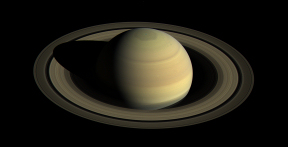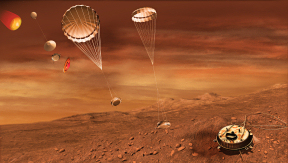Catching Cassini's call
13 January 2017
This week, ESA deep-space radio dishes on two continents are listening for signals from the international Cassini spacecraft, now on its final tour of Saturn. |
| Above Saturn. Credit: NASA/JPL-Caltech/Space Science Institute |
ESA's sensitive tracking antennas at New Norcia, Western Australia, and Malargüe, Argentina, are being called in to help with crucial observations during Cassini's last months in orbit, dubbed the 'Grand Finale'.
The Cassini–Huygens mission is one of the most successful exploration endeavours ever.
Launched in October 1997, the Cassini orbiter delivered Europe's Huygens probe to the surface of Saturn's mysterious moon Titan in 2005, just a few months after becoming the first spacecraft to enter orbit around the giant gas planet.
In addition to Huygens' historic delivery 12 years ago on 14 January, Cassini has returned a wealth of information from Saturn's system, including images and other data from the massive planet, its multiple moons and its hauntingly beautiful system of rings.
Now running low on fuel, Cassini will be commanded to dive into Saturn's upper atmosphere on 15 September, where it will burn up like a meteor.
 |
| Huygens landing on Titan. Credit: ESA–C. Carreau |
As part of its final ambitious observing plan, the craft began last month making a series of 20 orbits, arcing high above the planet's north pole then diving down, skimming the narrow F-ring at the edge of the main rings.
Then, starting in April, Cassini will leap over the rings to begin its final series of 22 daring dives, taking it between the planet and the inner edge of the rings.
Between December 2016 and July 2017, ESA' ground stations will work with NASA's Deep Space Network to record radio signals transmitted by Cassini across 1.6 billion km, helping scientists to study Saturn's atmosphere and its enigmatic rings, bringing us closer to understanding its origins.
| New Norcia tracking station. For video details and downloads click here. Credit: ESA |
They will record signals transmitted from Cassini that have crossed or bounced off Saturn's atmosphere or rings. Variations in the strength and frequency contain valuable information on the composition, state and structure of whatever they have passed through.
In addition, tiny wobbles in Cassini's orbit due to the varying pull of gravity can be teased from the signals, helping to build our understanding of the planet's interior.
The first three recording passes involving ESA stations were conducted in December, followed by two more on 3 and 10 January. Twenty more deep-space link-ups are scheduled.
"For the first few months of 2017, we're mostly recording signals that will transit through the ring system or the atmosphere," says Daniel Firre, the service manager at ESA's mission control centre in Darmstadt, Germany.
"After April, as Cassini's orbit gets lower, we'll switch to recording signals to be used for gravity analysis."
| Cassini Ring Dive Ride Along. For video details and downloads click here. Credit: NASA/JPL-Caltech |
The recordings – some batches comprising up to 25 GB – are passed to the Cassini radio science team for analysis.
"The ESA stations are helping to acquire extremely important radio science data from Cassini, highlighting how interagency cooperation can make planetary missions even more valuable," notes Aseel Anabtawi, from the radio science group at NASA's Jet Propulsion Laboratory.
Some recording contacts between Cassini and Earth will last over 10 hours, and require technically complex handovers of the signal from an ESA to a NASA station and vice versa. In addition, specialists in Darmstadt must perform very precise frequency calculations for the recording passes.
"Supporting Cassini radio science for the mission's Grand Finale requires not only teamwork at ESA, but also deep collaboration between the agencies," says ESA's Thomas Beck, responsible for ground station services.
"This is part of our continuing mutual support that is yielding real scientific and engineering value."
(This article was originally published on ESA's Operations Portal)


